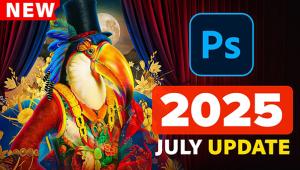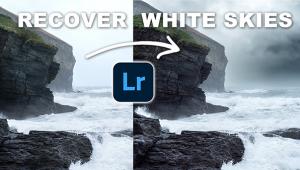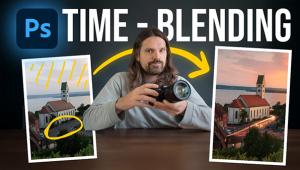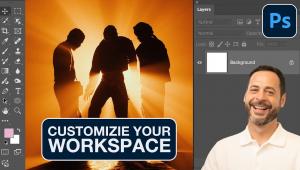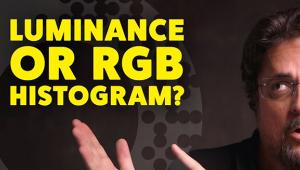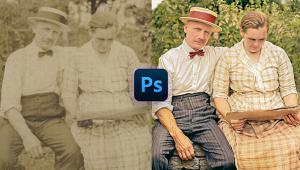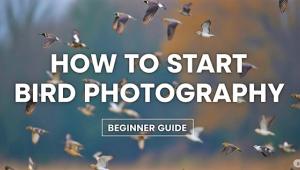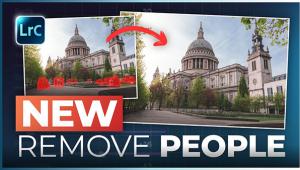Q&A For Digital Photography
To aid us in making Digital Help as helpful as possible, please be specific in your query and include components, including software, that you use. David says, “Make me guess the problem and I might guess wrong.”—Editor
Millenniata Disc Drives—For PCs And Macs?
Q. In your article on Millenniata Discs (December, 2011, issue of Shutterbug) you indicated that you were able to use an LG BE12LU30 drive to record on. The Millenniata website does not sell this drive but only a model that cannot be used on Apple OS X. Can you help me to select the correct drive to record these new discs?
Cynthia Harrison
via e-mail
A. I checked the sales section of Millenniata’s website and found that the LG BE12LU30 disc drive that Millenniata sent me to use is not included among the three drives that are currently offered. I spoke with Millenniata and found they do expect the drive I used in my Shutterbug report will be available, but exactly when they cannot say. However, the CP40NG10 and the BP40NS20 drives will work with Apple Mac computers. Just plug the USB connection in and you can write and read Millenniata M-Discs. And written M-Discs will read with any contemporary CD drive on an Apple Mac, and no software needs to be installed on your Mac.
Upgrade To Apple Lion OS 10.7?
Q. I have a Mac mini running Leopard. I would like to go with Lion so I can use some apps, but I have heard some people have had problems with Lion. Your opinion?
Skip Hupp
Ottawa, IL
A. I have one Apple Mac mini that was new a few months ago and came with Apple Lion OS 10.7 installed. I also have four more Apple Macs that are running Snow Leopard 10.6.8, all of which have been upgraded to the latest version of Snow Leopard. I do not plan to upgrade any of these four Macs to Lion 10.7.
The one mini that is 10.7 has some disadvantages as some older software applications require upgrades. I am not opposed to upgrades in general, but the only thing Lion offers are iOS 5 apps, which I do not need, and the few applications that are new and run only on 10.7 are not necessary to my work. Plus, some of my older applications will not run on Lion OS 10.7. I am sure Apple will continue to support Snow Leopard OS 10.6 into the foreseeable future.
Large Format Scanner
Q. I have a Calumet 4x5 Monorail in perfect condition. I would like to use the camera to expose black-and-white film, which I will process and then scan the negatives. At one time Epson made a scanner that would scan 4x5 negatives but it seems they no longer do. Does anyone make an affordable 4x5 scanner?
Buck Wicker
Pineola, NC
A. Epson makes the only consumer scanner that will scan all sizes of film from 35mm up to and including 8x10. The Epson Perfection V700 Photo Scanner ($599, list price) provides high resolution and fine performance and was reviewed in Shutterbug. Type Epson V750 or Epson V700 into the Search box at: www.shutterbug.com.
EIZO Calibration
Q. I am very happy with my new computer and my EIZO monitor, the ColorEdge CG243W. I have been calibrating it with the ColorEyes Display Pro 3. You suggested 90.0 cd/m2 luminance and I cannot get the monitor to accept that white luminance target. It constantly puts me at somewhere between 70 and 80. In reading the EIZO literature, they say the default is 80.0 CD/m2. Have you any familiarity with this? My prints are in sync with what I see on the monitor at about 72.0 CD/m2. Any ideas?
Mary Ruppert
via e-mail
A. The EIZO ColorEdge is designed to be adjusted, calibrated, and profiled directly using hardware inside the display and its color is controlled directly by the EIZO application on your computer through a USB connection between the display and your computer. Using the ColorEdge software and connecting the display to your computer, set the display to the white luminance aim point; for that display 80.0 CD/m2 is correct for photography. You should have documents and instructions from EIZO as to how to install the software and use USB to connect the display to your computer and the EIZO software. If you don’t use the EIZO ColorEdge as it is designed, then you probably never will obtain all the high performance you paid a lot of money to have and use.
The ColorEyes Display Pro is good but it cannot replace the EIZO ColorEdge system and will not provide optimum display performance.
A Pro Graphics LCD Display And A Laptop
Q. Can I successfully use my MacBook Pro with a Dell U2410 monitor and be able to get all the calibration and profiling right?
Rick Herbert
via e-mail
A. The Dell UltraSharp U2410 will connect to a MacBook Pro using an Apple Adapter to connect the Mini DisplayPort. Both the UltraSharp and the X-Rite i1Display Pro have been reviewed in Shutterbug. Adjusting, calibrating, and profiling a desktop LCD display connected to a MacBook Pro is identical to working with any other Apple Mac computer. I don’t see any significant difference whether my U2410 is connected to my Mac mini or Mac Pro computer.
Apple Thunderbolt Display
Q. I have read a lot of your Digital Help tips, and now have a question about displays. Does the Apple Thunderbolt Display have the same issues with display quality as the iMac? I am looking for a new 27” monitor for use with Apple systems in the same price range.
John Butera
via e-mail
A. The short answer is yes. The characteristics and specifications of the Thunderbolt are essentially the same, as well as the controls for adjustment. It is basically a high-quality sRGB color range home/office display, and is not a professional graphics display like those that I have tested and recommended for use editing digital photographs.
There are lots of similar home/office displays on the market that compete in performance with the Apple Thunderbolt, but none of the professional graphics displays in that size are similar in cost and are usually much more expensive, whether you choose NEC, EIZO, or LaCie brands.
Three Questions
Question 1. According to David Taylor in his book Digital Black & White Photography, “A Bayer sensor is divided into a rectangular array of millions of photo sensors, grouped into fours. The information from these four photo sensors is combined to produce one pixel in the final digital photo file. It is the number of pixels created this way that determines the resolution of the camera.” If I interpret this correctly, a 12MB sensor (e.g., on a Nikon D700) has 48MB of photo sensors (a.k.a. photo sites). Of all the books I’ve read on this subject, I have never read this! What is correct—one photo sensor to one pixel or four to one pixel?
Question 2. Conventional wisdom seems to be that an image file resolution of 300ppi is about right when printing. However, Scott Kelby in his book The Photoshop Elements 10 Book for Digital Photographers states that: “He never prints with a resolution higher than 240ppi.” Ditto for Tim Daly in his book Printing for Digital Photographers. Somewhere I read that one should use 300ppi for Canon printers and 360ppi for Epson printers. So how is one to know what is best?
Question 3. Say you have an image file that equates to 14.187x9.44” at 300ppi. You want to print it at 12x8”. Not resampled, this will result in a resolution of 354ppi; however, you do need to resample if printing at 300ppi. Does printing at 354ppi degrade the print more or less, or not at all, compared to printing at 300ppi? Ditto for when you need to print larger, e.g., printing at 300ppi resampled vs. printing at 250ppi not resampled?
Gary Irons
Marriottsville, MD
A. 1) It is quite clear that the specification of manufacturers is pretty unanimous that each sensor cell creates one image pixel. They all pretty well agree (although the three-layered Foveon chip in Sigma cameras confuses many) that the standard sensor uses lateral interpolation to get single color sensor information added into each image pixel. But that result does not demand that the pixel count should be divided; it remains the same. I would guess that the statement you quoted was an editing error or misinterpretation of the information the writer was sourcing. So you are correct that it does not take four sensors to create one image pixel, but it takes information from the three colors, RGB, in separate sensor cells in processing to get an RGB color pixel.
2) It is really an individual’s choice (within a practical range) regarding viable image resolution choices. Printer makers offer a range that will reproduce good perceptual print quality, typically from a low of 180ppi to as high as 400ppi. But if your original source image is the same, say 3000x4000 pixels, the rational choice is to get as much information into a print as possible so it will be seen at a normal distance as having good image quality. If the perception distance is greater, fewer pixels per square inch are needed to produce good image quality. If smaller, more pixels need to be put into the print. So to make a choice of ppi count for printing you need to consider how big the print is, and thus how close or far a viewer will be when viewing it. The smaller the print size the higher the ppi count of the image needs to be; the larger the print a lower ppi count will produce the same perceptual image quality.
3) Here you are asking if there is a difference that will affect image print quality in two print sizes not much different from each other that would be viewed from a very similar distance. Probably the change, if any, in ppi count from 354ppi to 300ppi would not be noticeable to most print viewers. In other words, changing the resolution of the original file setting in this case is not relevant to viewed quality. But there are practical considerations such as file size to consider. Image files of a 3000x4000 pixel image at 400ppi will be rather large resampled up to a print size of 30x40”. So the question becomes—do you need that high a resolution for a print that size?
Probably not.
ANNOUNCEMENT
I am pleased to announce the latest 4.3 Edition to my eBook Digital Darkroom Resource CD. The CD now contains 33 chapters totaling 399 pages in Adobe Acrobat .PDF format, providing easy-to-read text and large high-quality illustration. The CD is available for $20 plus $5 shipping and handling (US Mail if available). Ordering is as simple as sending a check or money order for $25 made out to me, David B. Brooks, and mailed to PO Box 2830, Lompoc, CA 93438.



















